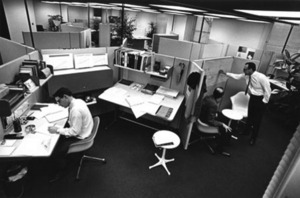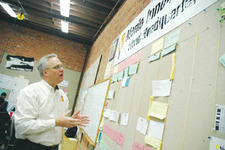Death to cubicles, Menlo Innovations CEO Rich Sheridan says
The cubicle - which was born 41 years ago in Ann Arbor - could also die here.
At least that would be the preference of Rich Sheridan, CEO of Ann Arbor software firm Menlo Innovations.

Herman Miller designers created the first version of the office cubicle at their Ann Arbor office in 1968.
Photo courtesy of Herman Miller
Sheridan’s reputation for preaching against cubicles as a catalyst for stodgy office environments is well-known. Today, he details his anti-cubicle passion in a blog post.
“Cubicles kill,” Sheridan writes. “They kill morale, communication, productivity, creativity, teamwork, camaraderie, energy, spirit, and results. They suck the joy out of work.”
Somewhere, Robert Propst - the Herman Miller furniture designer whose Ann Arbor team created “mobile office furniture” in 1968 - is likely seething.
But Menlo’s collaborative office environment is a way of life. Sheridan regularly points out that at his company, software engineers work side-by-side at shared computers and change work partners on a weekly basis.

Menlo Innovations Rich Sheridan is a crusader against cubicles.
Sheridan writes:
“One of the first things people notice when they visit our space for the first time is that there are no private offices, walls, cubes, or doors. On a walking tour they learn that most people at Menlo do not even have their own desk, chair, or computer. People are often surprised by this lack of personal space as they contemplate what it might be like to work here. I’m sure they’re thinking of their own work environments, where they have a cube or private office. They believe that this physical separation from their teammates produces greater productivity and a better environment for personal contributions.”
For Menlo, the no-cubicle philosophy has been fruitful.
It's among the hottest companies in Ann Arbor. In November, the firm won its fifth straight Fast Track award - a competition organized by Ann Arbor SPARK that honors companies with revenue in excess of $100,000 that have achieved average annual revenue growth of at least 20 percent for the last three years.
Contact AnnArbor.com’s Nathan Bomey at (734) 623-2587 or nathanbomey@annarbor.com. You can also follow him on Twitter.


Comments
Mr. Spock
Wed, Mar 3, 2010 : 11:16 a.m.
Corporate America used to use personal offices which gave employees a sense of self respect and privacy as human beings. To save money, cubicles became popular and although it was less private, you still had your personal space and could be productive but possibly sometimes distracted by conversations and activities in nearby cubicles. Today, some of the so-called "think outside the box" executives love the "Collaborative Environment". This post is a great example of not having to buy as much office equipment (cubicles, computers, desks, phones, etc.) to save money while also cramming workers into one room with no place to call home, no desk, no computer that they have access to (share our computers and our illness!) and no privacy whatsoever. Other countries have this same mindset for their workers. It's called a sweat shop.
Stuart Berman
Tue, Jan 5, 2010 : 8:48 a.m.
I think the real learning is that you no longer say "so and so sits here..." the benefit comes when people can work where they want/need to work when they need to work. There are times throughout the day when I need to work in a collaborative environment and a large open setting with others may be perfect. At other times I need a very quiet environment without distractions so I will just move to a quiet area. The key will be for designers to create those areas and for management and the workforce to embrace the change in culture this engenders.
roz
Sun, Jan 3, 2010 : 1 p.m.
Thanks, Rich, for the handsome offer to see Menlo from the inside. Your response addressed some of my primary concerns coming from the "kill the cubicle" statement. (Would "generalizations kill" be an apt generalization, do you think?) In my experience, workplace environments tailored to the specific goals and personality of the organization are powerful. People who see something working in one company who try to clone it into another location (for instance, the many failures at trying to copy what Jack Welch did at GE) are making a huge mistake. It's exciting to see a team meshing its people and its goals into something new -- sounds like that's what you're up to.
A2K
Fri, Jan 1, 2010 : 12:21 p.m.
As someone in a design/creative position, I share an office with 2 other people which is very distracting. I'd prefer to have my own office where it's nice and quiet, where I'd be able to focus completely on tasks instead of having people running in/out talking all day long.
Rich Sheridan
Thu, Dec 31, 2009 : 10:02 a.m.
Wow! I didn't expect all the attention to this particular blog post but clearly I've struck a chord (even if a dissonant one!). The comments that have been posted have raised some interesting questions and made some intriguing assumptions about Menlo itself and about the nature of an open and collaborative work environment. I'd like to explore these further. However, if I am the one answering all the questions and offering up all the opinions, it will naturally be suspect. So I'm going to ask my team and others we've come in contact with to contribute to the blog and speak to the issues and concerns raised here. My goal with this particular blog post and my life's work (perhaps contrary to Nathan Bomey's provocative headline) is not to "Kill the Cubicle" but rather to create a joyful work environment for me, my team and my customers. I also don't assume that Menlo has "THE answer" to workplace joy. I do believe, however, based on my experiences and observations that we do have "AN answer" and one that the world is welcome to explore and interrogate. We conduct about a tour-a-day at this point and our public tours have become quite popular as well. I would be happy to schedule a special tour to Ann Arbor.com readers if there is interest. I could arrange time for some of my team members to be available for Q & A. It might be worth mentioning that there is no corner office for the CEO either! I share a five foot aluminum table with a member of my team right out in the open space with the rest of the team. My personal managerial philosophy is that I would never expect someone on my team to do something I wouldn't be willing to do myself. I look forward to further exploration of the topic! Thanks for your passion...
fkm
Thu, Dec 31, 2009 : 9:59 a.m.
Menlo's open collaborative environment is part of a system which includes paired programming, visual project management, standup meetings, etc. I believe it originated with the task force concept - when a project is in trouble, typically a task force is formed and a war room created. If it works in a crisis, why not implement the same environment to do the day-to-day project work from the outset. Menlo's work environment does just that.
larry
Wed, Dec 30, 2009 : 2:40 p.m.
I like the privacy that cubes offer.
Macabre Sunset
Wed, Dec 30, 2009 : 2:18 p.m.
It works for some businesses. Hard not to notice that both IBM and Microsoft thrived under the concept that creatives need both walls and doors. The morale in tech places I've worked in that had cubes or the open concept was much lower. Some people simply give up trying to be creative and spend the day socializing because they simply can't concentrate with all the distractions. I wonder what's happened to all the '90s startups that would even encourage you to bring your dog to work?
Chris Grant
Wed, Dec 30, 2009 : 11:44 a.m.
Thank you very much for the following sentence: "For Menlo, the no-cubicle philosophy has been fruitful." It implies that the right kind of environment is the one that matches the work. Menlo has (at least in the eyes of the owner) found the right match for them. I was one of the people on Robert Propst's Ann Arbor team and I'd like to comment on just a couple of things. 1) Propst (and the Ann Arbor group known as Herman Miller Research Corporation) didn't *invent* the cubicle, he just adapted ideas that were being used in Europe at the time regarding the tradeoff between distraction, teamwork, and personal preferences. As part of the adaptation process, we did however *study* the effects of various office design concepts, particularly the two ends of the spectrum in use at the time in the USA: private offices and bullpens. We also studied and tried the no-territory concept that's currently incorporated into Menlo's approach, as well as many other office styles. Although the open-plan ideas usually, in the real world, were applied cookie-cutter-like, that was the unfortunate result of organizational economic reasons (cookie-cutter is cheaper). 2) The original organization morphed later on into a group called The Facility Management Institute, whose mission was to make so-called open plan offices as valuable as possible given the often conflicting needs of the people, the work process, and the physical and financial aspects of the setting. One of the main themes of the FMI was matching work to environment to human needs, and we spent a lot of time using workstyle testing (workstyles of the individual people; workstyles of the organization or department or workgroup) and developing typologies of offices to go with them. The message was loud and clear that you need a mix, and the components of the mix depend on the job, the people, and the overall situation. It sounds to me as if Rich Sheridan's philosophy of environment is very similar to what we were trying to find alternatives to. It's a one-size-fits-all approach based on big, big generalizations like "cubicles kill." Which brings me back to thanking you for the more rational viewpoint of your sentence "For Menlo, the no-cubicle philosophy has been fruitful." That, at least, is more believable than "cubicles kill."
Mike D.
Wed, Dec 30, 2009 : 11:37 a.m.
Open plans only work when everyone is quiet or everyone is noisy. If you have salespeople and programmers or writers in the same room, the programmers or writers will eventually want to kill the salespeople for being too loud. The salespeople can't help it; it's part of their job to be animated. I can only assume that Menlo somehow segments off the salespeople (if they are even on premises) from the developers.